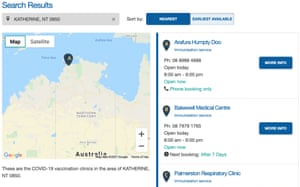“>
The frustration began last Wednesday, when the government blindsided many GPs by publicly telling Australians to flock to a new government website, which checked their eligibility for the vaccine and then linked roughly 6 million eligible patients with about 1,000 GP clinics currently activated to distribute the vaccine.
GPs were immediately inundated with calls. With no vaccine supply to speak of, most simply could not book patients in.
“I know practices that fielded 1,000 phone calls on that day. Our phones, we didn’t count them so I couldn’t tell you how many,” Davidson says. “But the amount of time and money that it cost for us just to explain to every patient that ‘I’m sorry, we can’t book you in’, ‘I’m sorry we don’t have any vaccine’.”
Even where shipments were promised last week, before the start of phase 1b on Monday, some simply didn’t show up.
Government correspondence obtained by the Guardian shows that, in some areas, there were “significant” delivery failures. In some cases, vaccines were showing up, but needles and disposal containers were not.
Other deliveries were delayed by the New South Wales floods.
Mukesh Haikerwal, a Melbourne-based GP and former president of the Australian Medical Association, was inundated with calls well before his clinic received any doses.
“The switchboard turned red again today,” he told the Guardian last Thursday. “It has just not stopped. Every time you put it down, another two come in.
“The message has to be that … we’ve got to do it in order, we’ve got to have vaccinations to do it. To say that 4 million people will be done on Monday, which is currently the message that went out, really wasn’t helpful to anybody.”
The huge demand was further compounded by problems with both the government’s website and private booking websites.
The flawed design of the government’s website suggested to some regional residents that they would have to drive hours, in some cases across state borders, to reach a participating GP clinic. In Tasmania, some residents were being told that one of their closest clinics was on the mainland.

In Esperance, Western Australia, residents were told by the website that the closest clinic was in Boulder, a four-hour drive away.
Residents of Mount Gambier, South Australia, were told the closest clinic participating in the Covid-19 rollout is across the state border in Portland, Victoria.
It was only after the Guardian’s reporting on the problem that the health department added a disclaimer explaining that 3,000 more clinics would be activated in coming weeks, and to check back if no clinic was yet available in a particular area.
Worse still, despite the huge lead-in time for the vaccination effort, the government’s website was not accessible to blind and visually impaired Australians. That prompted deep frustration from Vision Australia’s Chris Edwards, the manager of the organisation’s government relations and advocacy.
“We all recognise on occasions the need to get information out quickly, but in this case, they’ve had a long time to prepare for this,” Edwards said.
Industry sources told the Guardian the website’s launch had been rushed – a claim disputed by government.
“We were shocked to see it had gone up because we had been told to prepare for it going live on Monday,” one source told the Guardian on condition of anonymity. “What the hell happened?”
A separate private booking website contracted by the government, HealthEngine, was also flawed. The site allowed users to book in for second doses within days of the first, despite government recommendations that a three-month gap was needed to give greatest efficacy.
fThere is no doubt that the vaccine rollout is one of the most complex, logistically challenging undertakings that has faced the Australian government.
It has been complicated further still by factors outside of the government’s control. International supply of the AstraZeneca vaccine has been restricted by the European Union, which has blocked hundreds of thousands of doses reaching Australia.
That has left the nation dependent on local manufacturing through CSL, which began releasing 830,000 doses for use on Tuesday, a huge achievement in the rollout effort.
There is also less urgency in Australia than other nations, which are still hit hard by community transmission.
Yet that is the very reason the government has repeatedly said that Australia has had time to plan its rollout, and conduct it carefully and with efficiency.
The time afforded to Australia allowed it to set targets that now seem laughable.

About 4 million Australians were to be vaccinated by the end of March. By Wednesday, about 312,502 doses had been administered. The government has shifted from promising all Australians would be vaccinated by October, to saying everyone would receive their first dose by October.
The Health department secretary, Prof Brendan Murphy, said the challenges in Europe had not been anticipated when the government set its initial targets.
“The challenge has been in Europe, they’ve got a raging pandemic and say that AstraZeneca need to make the European commitments before they will allow exports. The reason they’re allowing the Pfizer exports is because Pfizer has been able to meet the European contractual commitments.
“AstraZeneca continues to try, we continue to try through various diplomatic channels, but we have no expectation that we will get the additional vaccines anytime soon. The supply countries are still contractually obliged to us and, and they may deliver, but we’re not counting on it.”
Regardless of the international constraints, there have been clear errors in Australia’s rollout.
One GP clinic, the Claremont Village medical centre, had specifically instructed the health department it did not want to be listed as a vaccination centre.
It was listed in error anyway.
“How does that error occur?” Labor senator Anne Urquhart asked in Senate estimates this week.
The associate health department secretary, Caroline Edwards, responded: “It’s a huge program, senator.”
The government has rejected suggestions that it rushed the announcement of the website, or that GP clinics were blindsided.
“Every GP practice knew that participating practices would be displayed in the clinic finder,” Murphy told Senate estimates this week.
The complaint from many GPs, though, was about the way the government communicated with the public. Expectations had been set that Australians would be able to book in for a vaccination at their local GP within a week, doctors said.
Notes from the last weekly primary care implementation group meeting held before last Wednesday’s website launch show the government was warned that it needed to carefully manage the public’s expectations. The government said it had the matter in hand.
Yet, the day after Wednesday’s announcement, the Royal Australian College of General Practitioners president, Dr Karen Price, warned that GPs were under an “extraordinary amount of pressure” and required better communication from government.
Price has since told the Guardian that the start of local manufacturing will allow greater certainty around supply, relieving some of the pressure GPs are facing.
Until then, though, clinics such as Davidson’s in Port Stephens will have to battle on, meeting huge demand with a pitiful supply of vaccines.
“Everyone has been working so hard,” she said. “Most general practices did not qualify for jobkeeper, we’ve all had massive amounts of costs.
“We’re the people who have kept working, through the entire pandemic.”

This content first appear on the guardian
